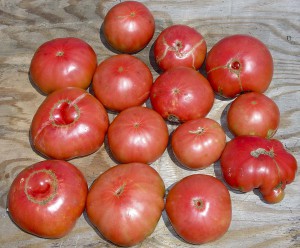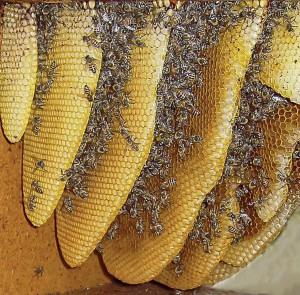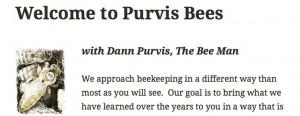Darrel Jones lives in a rural area in northern Alabama. He is an enthusiastic grower of heirloom tomatoes, http://www.selectedplants.com/ Being a beekeeper as well is a natural fit with his gardening activities. Keeping bees treatment free was his goal from the time he first saw varroa mites in 1993.
 Brandypeace, an heirloom tomato of Darrel Jones.
Brandypeace, an heirloom tomato of Darrel Jones.
In 2004 he found a single feral swarm that showed significant varroa tolerance. He saw a lot of hygienic behavior and uncapped pupae with mites combined with very low overall mite numbers. It showed some unwanted characteristics as well with a high stinging tendency and yearly swarming. He concluded that the swarm was a combination of typical Apis mellifera mellifera with Italian bees. The bees flew at low temperatures and overwintered on very small amount of honey reserves.
Combination partner
He purchased 10 queens of mite tolerant stock from Dann Purvis and used them as drone source colonies next year when he raised queens from his feral tolerant swarm. A couple of years he deliberately encouraged his new colonies to swarm planning they would stay in the vicinity and establish a good buffer of resistant drones for his virgins to mate with. He pushed more than 60 swarms into the woods.
Darrel says there are many feral bees living in the forest around where he lives. And he catches some feral swarms in swarm traps every year. He could easily catch more if he wanted to.
Breeding better beekeepers’ bees
There are about 100 managed colonies some miles east of him, but they are far enough away that there is no risk of interfering with the matings of his virgin queens. His conclusion is that they don’t interfere with the matings of his virgins. At least to any degree it matters.
Today he has 14 colonies in four apiaries. One apiary is far away (200 km) from any other bees including his own. This apiary gives him possibility to mate virgins somewhat differently or with an experimental drone source.
Bringing in external mite resistant stock
In 2011 he bought 3 queens from Mike Carpenter. Mike has been selecting for bees that groom and injure mites (Allogrooming, bees grooming each other from mites). Darrel wants to combine different varroa resistant traits in his stock and also reduce stinging tendency and swarming behavior.
He bought 3 queens from Bweaver in 2015. These bees are advertised as treatment free and from evaluation, are very hygienic. He found the resulting colonies to have good temper but they produced many swarms out of the normal swarming season.
The traits he is selecting for in his breeding are decent honey production with at least 60 pounds per year, very high mite tolerance, good quality honey, and overwintering with small clusters that build up very fast in spring. He selects against high tendency to swarm and aggressive behavior. He is not satisfied here yet, but working on it.
Africanized bees
Africanized bees are not currently present in North Alabama. Cold winter temperatures will prevent highly Africanized stock from surviving in his climate. They probably will be able to survive if crossed with bees that form clusters and winter well.
Bweaver is situated in Texas, declared as heavily Africanized. Their bees show significant introgression of traits but without the increased stinging impulse typical of Africanized bees. Darrel has decided to replace the 3 queens he bought from there, with his own stock, which winters better. He says Africanized bees have some good traits that could be exploited in combination breeding
Spreading the stock
His goal is to spread treatment free stock in the surrounding area. For this reason, he has sold a total of 25 colonies to 3 local beekeepers. They too are also keeping their bees treatment free. Darrel has an agreement with these three beekeepers to share stock when it comes to raising queens from the best breeders. In 2016, he plans to make another 10 colonies to start other beekeepers with mite tolerant bees.
Cell size
He uses standard Langstroth equipment with 11 frames (instead of 10) and 31 mm end bars (instead of 35 mm). He also uses small cell 4.9 mm wax foundation. He has a few colonies on 5.3 mm cell size and sees no difference in varroa tolerance or honey production. But the large cell colonies build up slower in spring. This is a bad factor for him and he doesn’t produce any more colonies on 5.3 mm.
 How to measure cell size. You can do three ways on a comb, or foundation. Two ways diagonal as well as straight.
How to measure cell size. You can do three ways on a comb, or foundation. Two ways diagonal as well as straight.
Infestation level
Darrel does not do any mite level checks. They are not necessary as he never has seen any big die offs or any bees with virus or wingless bees with DWV. He did check one random colony in 2014 to see how many mites were dropping naturally. Some other beekeepers had asked because they thought his bees were full of mites. This colony dropped 15 mites in 48 days proving them wrong. This makes a downfall of 0.3 mites per day.
Conditions and characteristics for Darrel Jones’ resistant stock
- His area is relatively isolated from nonresistant bees.
- A large population of feral resistant bees are established in the vicinity. This is quite a different situation compared especially to many European areas with bees.
- He began with bee stocks that have excellent resistant traits.
- He is not bringing in non-resistant bees in the form of queens, nucs, or colonies.
- He is at most trying a few new queens from outside per year.
- Small cell size is positive for colony build up but not necessary for resistance.
- No treatments of any kind have been used for the last 11 years. Natural mite resistance in his bees is enough that they are thriving.
- Yearly sales of honey pay all expenses to sustain his beekeeping activities.



Very good blog and summary/conclusions! It was a pleasure to read this contribution.
I was not aware that so many people a working on the same target and successfully since years. Very encouraging!